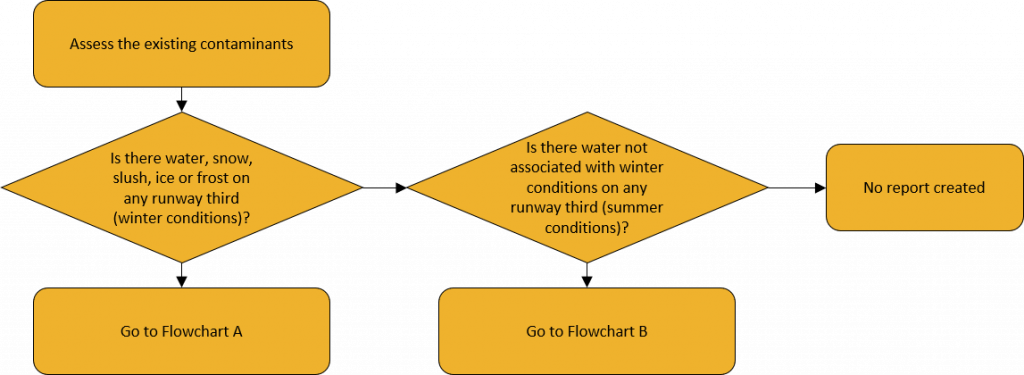The International Civil Aviation Organization (ICAO) flowchart has been published as guidance for the runway inspectors. The flowchart helps the inspectors on how to report runway conditions according to GRF regulations.
The flowchart begins by observing each runway third and its contaminants and consists of two scenarios, namely Flowchart A (winter season) and Flowchart B (summer season).

The basic runway condition assessment matrix (RCAM) flowchart process (adapted from ICAO, 2019, Circular 355, Assessment, Measurement and Reporting of Runway Surface Conditions)
Flowchart A
Step 1: RCAM applicability
In the winter season, the runway inspector observes the runway to assess if there is water, slush, snow, ice or frost on any runway third. If there is, the inspector should follow Flowchart A.

Flowchart A (adapted from ICAO, 2019, Circular 355, Assessment, Measurement and Reporting of Runway Surface Conditions)
Step 2: Apply coverage criteria
In the winter season, the flowchart begins by assessing the coverage percent of each third. The inspector should assess if the coverage is more than 10% on any runway third.
-
- If the answer is no, there is basically no need for a runway conditions report (RCR). Nevertheless, it is never wrong to report even small coverages in the winter season.
- If the answer is yes, the inspector should check if the total coverage of a specific runway third is more than 25%.
- If the answer is no, the inspector should report the contaminants observed and the runway condition code ((RWYCC)) six for that specific runway third.
Step 3: Apply assessment criteria
- If the total coverage is more than 25%, the runway inspector should assess the type and the depth of the contaminants for each third and assign a specific RWYCC. It means that the runway inspector should use the RCAM table or Global Runway Reporter software and decide about the contaminant or contaminants combination representing a certain RWYCC.
- When the contaminant type, depth and coverage percent has been determined on runway third, the inspector should assess the need to downgrade or upgrade the RWYCC on that specific runway third.
- If it is not necessary, the inspector should report determined contaminants and their nominal RWYCC for that specific runway third.
Step 4: Apply downgrade and upgrade criteria
- If there is a downgrade or upgrade need, the inspector should determine this by using all available information. It means all indications should support the upgrade or downgrade decision and the RCAM table should be used in the assessment. National regulation should always be followed by the upgrade and downgrade allowance. In this case, the runway should be reported with the corrected RWYCC for this specific runway third.
Global Runway Reporter (GRR) software mobile module
Assessment of runway conditions can efficiently be handled by using the Global Runway Reporter Mobile application. GRRM software is the actual runway inspector’s tool to make RCRs. The software calculates automatically RCAM contaminants and helps the inspector to select the correct RCAM code with upgrade and downgrade possibilities. The runway inspector reports contaminants directly from the inspection vehicle and generates consistent SNOWTAM syntax.

